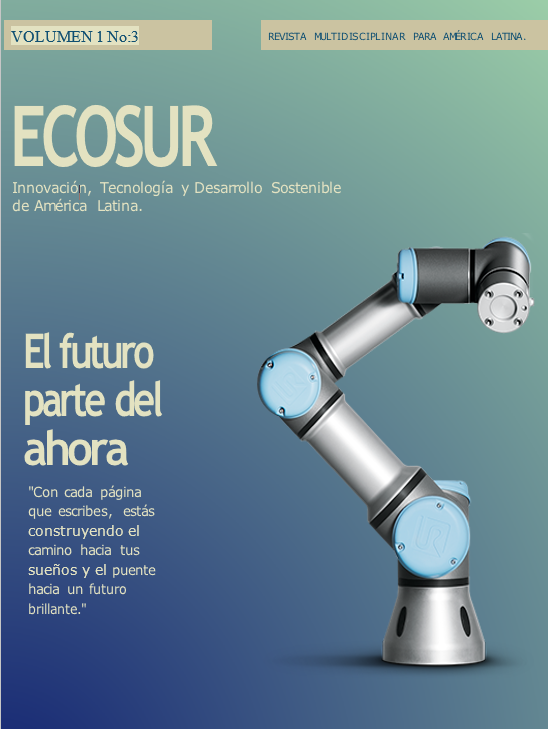Robots competitivos: una nueva herramienta para el aprendizaje
DOI:
https://doi.org/10.61582/fk2g7764Keywords:
competiciones, robotica, educación, ingenieriaAbstract
Robots have become a leading field of interest at the intersection of engineering, robotics, and education, especially in educational competitions. These competitions offer a unique platform to foster creativity, critical thinking, and the development of technical skills in students of all ages. The design of a climbing robot is framed within the scope of educational competitions, encompassing essential components for a comprehensive learning experience. First, the electronic design involves the development of circuits and control systems that allow the robot to climb efficiently and safely. The mechanical design focuses on creating a robust and adaptable structure that facilitates the robot's vertical movement. The mathematical modeling of the motor is essential to understand and optimize the performance of the power source, while the dynamic model of the system provides a holistic view of the interactions between the components. Finally, the mathematical model becomes a fundamental tool for simulation and analysis, allowing students to explore mathematical and physics concepts applied in the context of climbing robotics.
References
A. O. Baturone, Robotica Manipuladores y robots moviles, España: Marcombo, 2001.
P. M. Almeida, «Uso de la robótica educativa como medio para favorecer la creatividad en la educación no formal,» RiiTE Revista Interuniversitaria de Investigación en Tecnología Educativa, 2021.
«arduino.cl,» MCI ELECTRONICS, [En línea]. Available: https://arduino.cl/arduino-nano/.
M. Á. Uvillus Chancusig, «Robot móvil para las competencias de insecto con obstáculos, sin obstáculos y trepador con corrección de trayectoria,» 2023. [En línea]. Available: https://dspace.ups.edu.ec/handle/123456789/24494. [Último acceso: 6 10 2023].
T. Luis y M. Néstor, «Diseño y construcción de dos robots escaladores con normativas técnicas del Concurso Ecuatoriano de Robótica,» 2018. [En línea]. Available: https://nexoscientificos.vidanueva.edu.ec/index.php/ojs/article/view/6/157. [Último acceso: 6 10 2023].
S. H. B. y. M. A. T. Saif K. Mahmood, «Magnetic-type Climbing Wheeled Mobile Robot for Engineering Education,» [En línea]. Available: https://iopscience.iop.org/article/10.1088/1757-899X/928/2/022145.
A. H. A. G. A. M. J. M. Ú. D. R. Ó. Peidró, «Modelado dinámico y simulación de un robot trepador tipo serie con 4 grados de libertad,» 2016. [En línea]. Available: https://ruc.udc.es/dspace/handle/2183/29233.
S. K. Saha, Introducción a la robótica, McGraw-Hill España.
T. B. C. H. &. T. L. K. Berns, «Developing Climbing Robots for Education,» 2005. [En línea]. Available: https://www.mendeley.com/catalogue/2d470922-4465-3a66-ba27-8730e4c863a3/.
D. G. Andreas Goransson, Professional Android Open Accessory Programming with Arduino, Jhon Wiley & Sons, 2013.
Downloads
Published
Issue
Section
License
Copyright (c) 2024 Raul Villon Tomala, Jackson Valverde (Author)

This work is licensed under a Creative Commons Attribution-NonCommercial-ShareAlike 4.0 International License.
EcoSur is an open access journal, which means that all users can access the content for free.
All our articles are available under the Creative Commons License (CC BY-NC-SA 4.0), the terms of Creative Commons Attribution-NonCommercial-ShareAlike 4.0 International (CC BY-NC-SA 4.0). This means that you are free to share (copy and redistribute the material in any medium or format) and adapt (remix, transform and build upon the material), under the following conditions:
Attribution: You must give appropriate credit, provide a link to the license, and indicate if changes were made. You may do so in any reasonable manner, but not in a way that suggests that the licensor endorses you or your use of the material.
NonCommercial: You may not use the material for commercial purposes.
Share Alike: If you remix, transform, or build upon the material, you must distribute your contributions under the same license as the original.
No additional restrictions: You may not apply legal terms or technological measures that legally restrict others from doing what the license allows.
For more information about this license and the full terms, visit Creative Commons CC BY-NC-SA 4.0 Deed.
How to Cite
Similar Articles
- Carlos Damián Asencio Suarez, Simulación y control: el secreto detrás de los robots seguidores de línea destreza , EcoSur: Innovation, Technology and Sustainable Development of Latin America: Vol. 1 No. 04 (2023): EcoSur: Innovación, Tecnología y Desarrollo Sostenible de América Latina.
- Douglas Yagual, ROBOT PARA COMPETENCIA EN CATEGORIA MINI SUMO , EcoSur: Innovation, Technology and Sustainable Development of Latin America: Vol. 1 No. 01 (2023): EcoSur: Innovación, Tecnología y Desarrollo Sostenible de América Latina.
- Lilia Ruiz Barcenas, KNOWLEDGE MANAGEMENT AND RESISTANCE TO CHANGE IN HIGHER EDUCATION INSTITUTIONS: PROPOSAL FOR INTERVENTION , EcoSur: Innovation, Technology and Sustainable Development of Latin America: Vol. 1 No. 7 (2025): EcoSur: Innovation, Technology and Sustainable Development of Latin America
- Roger Carbo, CONTROL Y MOVIMIENTO DE UN ROBOT INSECTO: UN ENFOQUE PRÁCTICO CON CONTROLADORES PID , EcoSur: Innovation, Technology and Sustainable Development of Latin America: Vol. 1 No. 01 (2023): EcoSur: Innovación, Tecnología y Desarrollo Sostenible de América Latina.
- Lisbette Rodriguez, Comunicación MATLAB-Arduino: Abordando Blink y Conceptos Fundamentales , EcoSur: Innovation, Technology and Sustainable Development of Latin America: Vol. 1 No. 01 (2023): EcoSur: Innovación, Tecnología y Desarrollo Sostenible de América Latina.
- Laura Vásconez, Andres Pinargote, Bryan Sanchez, Julissa Orrala, Jason Ramirez, Ariel Buenaño, CONTROLADOR DE POSICION Y VELOCIDAD CON PID DISCRETO EN MOTOR DC CON CODIFICACION , EcoSur: Innovation, Technology and Sustainable Development of Latin America: Vol. 1 No. 02 (2023): EcoSur: Innovación, Tecnología y Desarrollo Sostenible de América Latina.
You may also start an advanced similarity search for this article.

